东大19春学期《分析化学》在线作业3【标准答案】
- 格式:doc
- 大小:19.54 KB
- 文档页数:6

东大18秋学期《基础化学》在线作业31、A2、C3、A4、C5、A一、单选题共40题,80分1、已知jΘ(Sn4+/Sn2+) = +0.14V,jΘ(Fe3+/Fe2+) = +0.77V,哪组离子不能共存于同一溶液?()。
AFe3+,Sn2+BFe3+,Fe2+CSn4+,Fe2+DSn4+,Fe2+正确答案是:A2、下列化合物中磷的氧化数最高的是()。
AH3PO3BH3PO2CH4P2O7DPH3正确答案是:C3、下列各组都为状态函数的是()。
AG、H、SBQ、H、GCS、V、WDP、T、W正确答案是:A4、当基态原子的第五电子层只有2个电子,则原子的第四电子层中的电子数为()个。
A8B18C8~18D8~32正确答案是:C5、某黄色固体化合物,不溶于热水,溶于热的稀盐酸,生成一橙色溶液,当所得溶液冷却时,有一白色沉淀析出,加热该溶液后白色沉淀又消失。
此黄色固体是()。
APbCrO4BHgOCAgIDCdS正确答案是:A6、下列各对物质在酸性溶液中能共存的是()。
AFeCl3 和KIBFeCl3 和KBrCFeCl2和Br2DKI和KIO3正确答案是:B7、下列分子中,其中心原子采用不等性sp3杂化轨道成键的是*** ()AH2SBBCl3CCH4DCO2正确答案是:A8、在一定条件下,反应的平衡常数KΘ 很大,表示该反应()。
A是放热反应B活化能很大C反应的可能性很大D反应的速度很大正确答案是:C9、零级反应的速率()。
A恒等于零B与反应物浓度成正比C与反应物浓度无关D与反应物浓度成反比正确答案是:C10、四个学生分别对一无色酸性未知溶液做定性分析,报告检出离子如下,其中正确的是()。
APO43-,SO32-,Cl-,NO2-,Na+BPO43-,SO42-,Cl-,NO3-,Na+CPO43-,S2-,Cl-,NO2-,Na+DPO43-,SO32-,Cl-,NO3-,Na+正确答案是:B11、已知jΘ(Sn4+ / Sn2+)=0.15V,jΘ(Pb2+ / Pb)=0.126V,jΘ(Ag+ / Ag)=0.799V。

……………………………………………………………最新资料推荐…………………………………………………国开大学《分析化学》形考作业题及答案(全套)分析化学形考任务(一)(请学习完第一、二、三章后完成本次形考作业)一、单项选择题(每题2分,共80分)1、在定量分析中,精密度与准确度之间的关系是(C)A.精密度高,准确度必然高B.准确度高,精密度也就高C.精密度是保证准确度的前提D.准确度是保证精密度的前提2、从精密度好即可推断分析结果可靠的前提是()A. 偶然误差小B.系统误差小C.标准偏差小D.平均偏差小3、下列叙述错误的是(A)A.偶然误差影响分析结果的准确度B.偶然误差的数值大小不具有单向性C.偶然误差在分析中是无法避免的D.绝对值相同的正、负偶然误差出现的机会均等4、下列哪种方法可以减小分析测定中的偶然误差(D)A.对照试验B.空白试验C.仪器校正D.增加平行试验的次数5、下列提高分析结果准确度的方法,那些是正确的(B)A.增加平行测定次数,可以减小系统误差B.作空白试验可以估算出试剂不纯带来的误差C.回收试验可以判断分析过程是否存在偶然误差D.通过对仪器进行校准减免偶然误差6、2.050×10-2是几位有效数字(D)A. 一位B. 二位C. 三位D. 四位7、按有效数字修约的规则,以下测量值中可修约为2.01的是()A. 2.005B. 2.006C. 2.015D. 2.016……………………………………………………………最新资料推荐…………………………………………………8、如果要求分析结果达到0.1%的准确度,使用一般电光天平称取试样时至少应该称取的质量是(B)A. 0.05 gB.0.1 gC. 0.2 gD.1.0 g9、滴定反应式t T + b B = c C + d D达到化学计量点时,T的物质的量与B的物质的量的关系是(B)A. 1:1B. t:bC. b:tD. 不确定10、在滴定分析中,关于滴定突跃范围的范围叙述不正确的是(B)A. 被滴定物质的浓度越高,突越范围越大B. 滴定反应的平衡常数越大,突越范围越大C.突越范围越大,滴定越准确D.指示剂的变色范围越大,突越范围越大11、定量分析中的基准物质的含义是(D)A. 纯物质B.标准物质C.组成恒定的物质D.纯度高、组成恒定、性质稳定且摩尔质量较大的物质12、强酸滴定强碱时,酸和碱的浓度均增大10倍时,则滴定突跃范围将(D)A. 不变B.增大0.5个pH单位C. 增大1个pH单位D.增大2个pH单位13、t mol的滴定剂T与b mol的被测物质B完全反应的点是(AC)A. 化学计量点B.滴定终点D. T与B的质量相等14、选择指示剂时可以不考虑(A)A. 指示剂相对分子质量的大小B. 指示剂的变色范围C.指示剂的颜色变化D. 滴定突跃范围15、某酸碱指示剂的K HIn=,其理论变色范围为(C)A.B.C.D.16、用NaOH溶液(0.1mol/L)滴定同浓度的甲酸(K a=)溶液,应选用的指示剂是(D)A. 百里酚蓝(pK In=1.65)B. 甲基橙(pK In=3.45)C. 中性红(pK In=7.4)D. 酚酞(pK In=9.1)17、下列滴定的终点误差为正值的是(CD)A. NaOH滴定HCl,用甲基橙为指示剂B. HCl滴定NaOH,用酚酞为指示剂C.蒸馏法测NH4+时,用HCl吸收NH3,以NaOH标准溶液返滴定pH=7.0D. NaOH滴定H3PO4至pH4.0时18、NaOH溶液的标签浓度为0.3000mol/L,该溶液在放置中吸收了空气中的CO2,现以酚酞为指示剂,用HCl标准溶液标定,其标定结果比标签浓度(B)A. 高C.不变D.基本无影响19、下列样品不能用冰醋酸-高氯酸体系滴定的是(A)A. 苯酚B.水杨酸钠C.磺胺吡啶D.邻苯二甲酸氢钾20、当HCl溶于液氨时,溶液中的最强酸是(C)A. H3O+B.NH3C.NH4+D.NH2-B.C.HClD.21、下列对苯甲酸说法不正确的是(C)A.苯甲酸在水溶液中酸性较弱B.苯甲酸在乙二胺中可提高酸性C.冰醋酸可用于苯甲酸的非水酸滴定的溶剂D.在水溶液中能用NaOH滴定苯甲酸22、下列关于Y(H)值的叙述正确的是(C)A. Y(H)值随pH的增大而增大B. Y(H)值随溶液酸度增高而增大C. Y(H)值随溶液酸度增高而减小D. lg Y(H)值随pH的增大而增大23、在Ca2+、Mg2+共存时,可不加掩蔽剂用EDTA滴定Ca2+的pH条件是(A)A. pH5B. pH10D. pH224、使用铬黑T指示剂合适的pH范围是(C)A.B.C.D.25、一般情况下,EDTA与金属离子形成的配位化合物的的配位比是(A)A. 1:1B. 2:1C. 1:3D. 1:226、M(L)=1表示(A)A. M与L没有副反应B. M与L的副反应相当严重C. M的副反应较小D. [M]=[ L]27、EDTA滴定金属离子,准确滴定(TE<0.1)的条件是(D)A. lgK MY 6B. lg K’MY 6C. lgcK MY 6D. lg cK’MY 628、指出下列叙述错误的结论(B)A. 酸效应使配合物的稳定性降低B.羟基配位效应使配合物的稳定性降低C.辅助配位效应使配合物的稳定性降低29、用相关电对的电极电位不能判断(D)A. 氧化还原滴定突跃的大小B.氧化还原反应的速度C.氧化还原反应的方向D.氧化还原反应的次序30、影响氧化还原反应的速度的因素不包括()A. 环境湿度的改变B.反应物浓度C.体系温度D.催化剂的加入31、影响条件电位的因素不包括(B)A. 电对的性质B. 催化剂C.氧化还原反应半反应中的失电子数D.电对氧化态或还原态发生沉淀、配位等副反应32、既能用滴定剂本身作指示剂,也可用另一种指示剂指示滴定终点的方法不包括()A. 重氮化滴定法B.碘量法C.溴量法D.KMnO433、下列不属于沉淀重量法对沉淀形式的要求的是(D)A. 沉淀的溶解度小B.沉淀纯净C.沉淀颗粒易于滤过和洗涤D.沉淀的摩尔质量大……………………………………………………………最新资料推荐…………………………………………………34、下列违反无定型沉淀的生成条件的是(D)A. 沉淀作用宜在较浓的溶液中进行B.沉淀作用宜在热溶液中进行C.在不断搅拌下,迅速加入沉淀剂D.沉淀宜放置过夜,使沉淀陈化35、在重量分析法中,洗涤无定型沉淀的洗涤液应是()A. 冷水B.含沉淀剂的稀溶液C.热的电解质溶液D.热水36、用洗涤的方法可除去的沉淀杂质是()A. 混晶共沉淀杂质B.包藏共沉淀杂质C.吸附共沉淀杂质D.后沉淀杂质37、在沉淀滴定中,与滴定突跃大小无关的是()A. Ag+的浓度B. Cl-的浓度C.沉淀的溶解度D.指示剂的浓度38、溶液pH测定时,需要用pH已知的标准溶液定位,这是为了()A. 消除酸差影响B.消除碱差影响C.消除温度影响D.消除不对称电位和液接电位的影响39、玻璃电极使用前,需要进行的处理是()A. 在酸性溶液中浸泡24小时……………………………………………………………最新资料推荐…………………………………………………B.在碱性溶液中浸泡24小时C.在水中浸泡24小时D.随测量pH变化,浸泡溶液不同40、双液接甘汞电极中硝酸钾溶液的主要作用是()A. 平衡电压B.防止腐蚀C.防止阳离子通过D.盐桥二、计算题(每题10分,共20分)1.用化学法与高效液相色谱法测定同一复方阿司匹林片剂中阿司匹林的含量,测得的标示含量如下:HPLC(3次进样的均值)法:97.2%、98.1%、99.9%、99.3%、97.2%及98.1% ;化学法:97.8%、97.7%、98.1%、96.7%及97.3%。
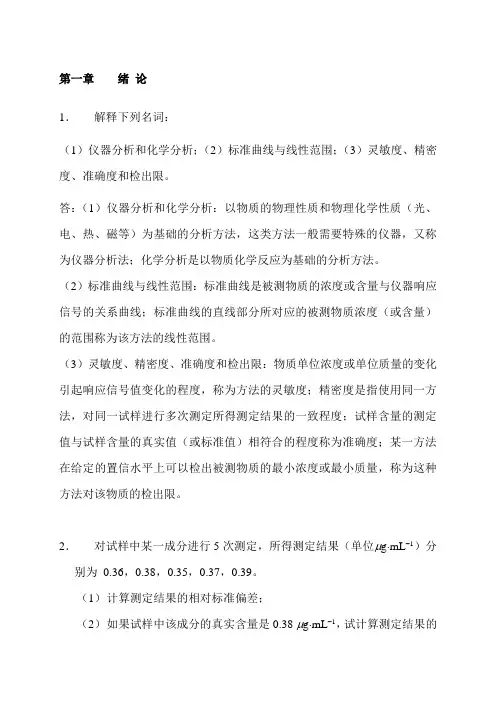
第一章绪论1.解释下列名词:(1)仪器分析和化学分析;(2)标准曲线与线性范围;(3)灵敏度、精密度、准确度和检出限。
答:(1)仪器分析和化学分析:以物质的物理性质和物理化学性质(光、电、热、磁等)为基础的分析方法,这类方法一般需要特殊的仪器,又称为仪器分析法;化学分析是以物质化学反应为基础的分析方法。
(2)标准曲线与线性范围:标准曲线是被测物质的浓度或含量与仪器响应信号的关系曲线;标准曲线的直线部分所对应的被测物质浓度(或含量)的范围称为该方法的线性范围。
(3)灵敏度、精密度、准确度和检出限:物质单位浓度或单位质量的变化引起响应信号值变化的程度,称为方法的灵敏度;精密度是指使用同一方法,对同一试样进行多次测定所得测定结果的一致程度;试样含量的测定值与试样含量的真实值(或标准值)相符合的程度称为准确度;某一方法在给定的置信水平上可以检出被测物质的最小浓度或最小质量,称为这种方法对该物质的检出限。
2.对试样中某一成分进行5次测定,所得测定结果(单位μg⋅mL-1)分别为0.36,0.38,0.35,0.37,0.39。
(1)计算测定结果的相对标准偏差;(2)如果试样中该成分的真实含量是0.38 μg⋅mL-1,试计算测定结果的相对误差。
解:(1)测定结果的平均值37.0539.037.035.038.036.0=++++=x μg ⋅mL -1标准偏差122222120158.015)37.039.0()37.037.0()37.035.0()37.038.0()37.036.0(1)(-=⋅=--+-+-+-+-=--=∑mLg n x x s ni i μ相对标准偏差 %27.4%10037.00158.0%100=⨯=⨯=xs s r(2)相对误差 %63.2%10038.038.037.0%100-=⨯-=⨯-=μμx E r 。
3. 用次甲基蓝-二氯乙烷光度法测定试样中硼时,为制作标准曲线,配制一系列质量浓度ρB (单位mg ⋅L -1)分别为0.5,1.0,2.0,3.0,4.0,5.0的标准溶液,测得吸光度A 分别为0.140,0.160,0.280,0.380,0.410,0.540。
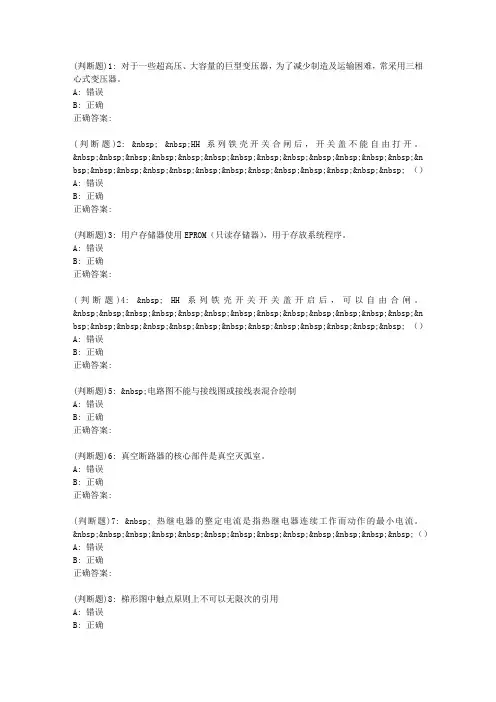
(判断题)1: 对于一些超高压、大容量的巨型变压器,为了减少制造及运输困难,常采用三相心式变压器。
A: 错误B: 正确正确答案:(判断题)2: HH系列铁壳开关合闸后,开关盖不能自由打开。
&n bsp; ()A: 错误B: 正确正确答案:(判断题)3: 用户存储器使用EPROM(只读存储器),用于存放系统程序。
A: 错误B: 正确正确答案:(判断题)4: HH系列铁壳开关开关盖开启后,可以自由合闸。
&n bsp; ()A: 错误B: 正确正确答案:(判断题)5: 电路图不能与接线图或接线表混合绘制A: 错误B: 正确正确答案:(判断题)6: 真空断路器的核心部件是真空灭弧室。


东大21春学期《分析化学》在线平时作业3提示:东北大学课程学习已经开启,本套试卷是课程学习辅导资料,只作参考学习使用!!!一、单选题 (共 10 道试题,共 50 分)1.铬黑T在溶液中存在下列平衡,它与金属离子形成络合物显红色,pKa2=6.3 pKa3=11.6H2In- HIn2- In3-紫红蓝橙使用该指示剂的酸度范围是()[A.]pH < 6.3[B.]pH > 11.6[C.]pH = 6.3~11.6[D.]pH =6.3±1[解析:请从上述选项中选择您认为正确的一项,并从填写到答案栏]参考答案是:C2.在下列各组酸碱组分中,属于共轭酸碱对的是()[A.]HCN-NaCN[B.]H3PO4-Na2HPO4[C.]+NH3CH2COOH-NH2CH2COO-[D.]H3O+-OH-[解析:请从上述选项中选择您认为正确的一项,并从填写到答案栏]参考答案是:A3.以下情况产生的误差属于系统误差的是()[A.]A)、指示剂变色点与化学计量点不一致[B.]B)、滴定管读数最后一位估测不准[C.]C)、称样时砝码数值记错[D.]D)、称量过程中天平零点稍有变动[解析:请从上述选项中选择您认为正确的一项,并从填写到答案栏]参考答案是:A4.氟离子选择电极对氟离子具有较高的选择性是由于()[A.]只有F-能透过晶体膜[B.]F-能与晶体膜进行离子交换[C.]由于F-体积比较小[D.]只有F-能被吸附在晶体膜上[解析:请从上述选项中选择您认为正确的一项,并从填写到答案栏]参考答案是:B5.用H2C2O4标定KMnO4,采用的滴定方式属于()[A.]直接滴定[B.]返滴定[C.]置换滴定。
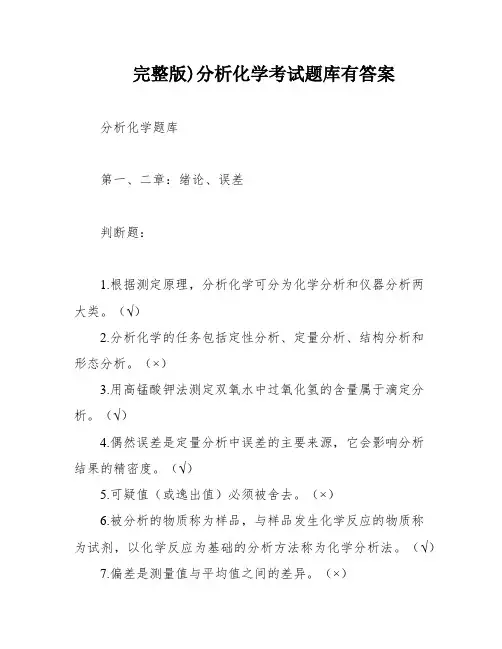
完整版)分析化学考试题库有答案分析化学题库第一、二章:绪论、误差判断题:1.根据测定原理,分析化学可分为化学分析和仪器分析两大类。
(√)2.分析化学的任务包括定性分析、定量分析、结构分析和形态分析。
(×)3.用高锰酸钾法测定双氧水中过氧化氢的含量属于滴定分析。
(√)4.偶然误差是定量分析中误差的主要来源,它会影响分析结果的精密度。
(√)5.可疑值(或逸出值)必须被舍去。
(×)6.被分析的物质称为样品,与样品发生化学反应的物质称为试剂,以化学反应为基础的分析方法称为化学分析法。
(√)7.偏差是测量值与平均值之间的差异。
(×)8.绝对误差是测量值与真实值之间的差异。
(√)9.增加平行测定次数,可以减少系统误差。
(×)10.当偶然误差被消除后,分析结果的精密度越高,准确度越高。
(×)11.在滴定分析中,测定结果的精密度越高,其准确度也越高。
(×)12.相对平均偏差、样本标准偏差、总体标准偏差都可用来表示测定值的分散程度。
(×)13.增加测定次数可以提高分析结果的准确度。
(×)14.用20 mL 移液管移取 NaOH 溶液,体积数应记为 20.00 mL。
(×)15.根据测定原理,分析化学可分为化学分析和仪器分析两大类。
(√)16.用酸碱滴定法测定醋酸的含量属于化学分析。
(√)17.化学分析是分析化学的基础,仪器分析是分析化学发展的方向。
(√)18.在一定称量范围内,被称样品的质量越大,称量的相对误差就越小。
(√)19.滴定管的初读数必须为“0.00 mL”。
(×)20.测定 0.8 mL 样品溶液的含量,属于常量分析。
(×)21.测定值与真实值相接近的程度称为准确度。
(√)填空题:1.配制用的蒸馏水中含有少量被测组分,此情况属于系统误差。
2.用 50 mL 移液管移取 NaOH 溶液,体积数应记为 50.00 mL。
![[东北大学]20年7月考试《分析化学X》考核作业(参考答案)](https://uimg.taocdn.com/c14c6e3d0029bd64793e2c38.webp)
东北大学继续教育学院分析化学X 试卷(作业考核线上2) A 卷(共 4 页)1、误差是指( C )A、某一测量值与其算数平均值之差B、含有误差之值与真值之差;C、测量值与其真值之差D、错误值与其真值之差。
2、下列说法正确的是( C )A、滴定过程中,指示剂发生颜色改变即为计量点B、精密度越高,则准确度越高C、称定NaOH溶液时,可以用邻苯二甲酸氢钾做基准物D、以上说法都正确3、下列有关随机误差的论述中正确的是( C )A、在消除了随机误差后,总体平均值就是真值B、随机误差具有单向性C、随机误差是定量分析中主要的误差来源D、随机误差在定量分析中是不可避免的4、在滴定分析中,所用试剂含有微量被测组分,应该进行( B )A、对照试验B、空白试验C、仪器校准D、方法校正E、增加测定次数5、在水溶液中,直接滴定弱酸或弱碱时,要求cKa或cKb( C )A、≥10-6B、≤10-6C、≥10-8D、≤ 10-8E、=10-86、NaOH标准溶液保存不当,吸收了CO2,使部分NaOH变成了Na2CO3 。
用这瓶NaOH溶液标定HCl溶液浓度,用甲基橙做指示剂,使测定结果( C )A、偏高B、偏低C、准确D、不能确定7、N离子共存时,可以用控制溶液酸度的方法准确滴定M离子的条件式为( C )A、lgK′MY -lgK′NY≥5 B、lgcMKMY-lgcNKNY≥5C、lgcM K′MY-lgcNK′NY≥5 D、lgcMKMY-lgcNK′NY≥5E、lgcM K′MY-lgcNKNY≥58、在EDTA溶液中,Y4-离子随酸度变化的酸效应系数α为:α=1+β1[H+]+β2[H+]2+β3[H+]3+β4[H+]4+β5[H+]5+β6[H+]6。
则式中β1,β2…分别代表的是( E )A、EDTA酸各级相应的电离常数,K a1,K a2…K a6B、EDTA酸各级相应的电离常数的倒数C、EDTA酸各级相应的累积电离常数D、EDTA酸各级相应积累的电离常数的倒数E、从EDTA最后一级电离常数(K a6)为起点的各相应积累电离常数的倒数9、对于反应Fe3++3I-=2Fe2++I3-,已知Φ0Fe3+/ Fe2+=0.771V,Φ0I3-/3I-=0.536V。
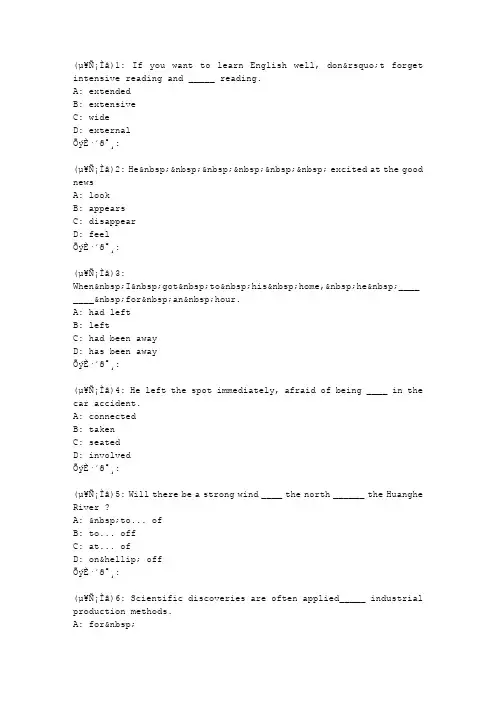
(µ¥Ñ¡Ìâ)1: If you want to learn English well, don’t forget intensive reading and _____ reading.A: extendedB: extensiveC: wideD: externalÕýÈ·´ð°¸:(µ¥Ñ¡Ìâ)2: He excited at the good newsA: lookB: appearsC: disappearD: feelÕýÈ·´ð°¸:(µ¥Ñ¡Ìâ)3:When I got to his home, he ____ ____ for an hour.A: had leftB: leftC: had been awayD: has been awayÕýÈ·´ð°¸:(µ¥Ñ¡Ìâ)4: He left the spot immediately, afraid of being ____ in the car accident.A: connectedB: takenC: seatedD: involvedÕýÈ·´ð°¸:(µ¥Ñ¡Ìâ)5: Will there be a strong wind ____ the north ______ the Huanghe River ?A: to... ofB: to... offC: at... ofD: on… offÕýÈ·´ð°¸:(µ¥Ñ¡Ìâ)6: Scientific discoveries are often applied_____ industrial production methods.A: for B: with C: to D: onÕýÈ·´ð°¸:(µ¥Ñ¡Ìâ)7: I asked the bank for a _____.A: loafB: loadC: loanD: loamÕýÈ·´ð°¸:(µ¥Ñ¡Ìâ)8: The teacher required that all the assignments _____finished before this weekend.A: would beB: wereC: beD: are toÕýÈ·´ð°¸:(µ¥Ñ¡Ìâ)9:Everyone except Tom and John ______ there when the meeting began.A: isB: wasC: areD: wereÕýÈ·´ð°¸:(µ¥Ñ¡Ìâ)10: A good habit can make our mental health in with physical health.A: concernB: connectionC: compareD: tuneÕýÈ·´ð°¸:(µ¥Ñ¡Ìâ)11: May she _______ with you?A: comeB: comesC: comingD: cameÕýÈ·´ð°¸:(µ¥Ñ¡Ìâ)12: Which is the best approach _____ the tunnel?A: toB: withC: besidesD: towardsÕýÈ·´ð°¸:(µ¥Ñ¡Ìâ)13:He could_____ neither French or German,&n bsp;so I____ with him in English.A: speak, talkedB: talk, toldC: say, spokeD: tell, talkedÕýÈ·´ð°¸:(µ¥Ñ¡Ìâ)14:Don’t spend _______ time on compute r games.A: too muchB: much tooC: too manyD: many tooÕýÈ·´ð°¸:(µ¥Ñ¡Ìâ)15: Many girls like __________ skirts in summer.A: wearingB: dressingC: inD: putting onÕýÈ·´ð°¸:(µ¥Ñ¡Ìâ)16:Look! Lily with her sister _________  ;a kite on the playground.A: is flyingB: are flyingC: flyingD: flyÕýÈ·´ð°¸:(µ¥Ñ¡Ìâ)17: My home is about ________ from my school.A: 15 minutesB: minute's rideC: 20 minutes by bikeD: 15- minute's on foot.ÕýÈ·´ð°¸:(µ¥Ñ¡Ìâ)18:The policeman stopped ________, but he&nb sp;_______ no sound.A: hearing,heardB: listening,listenedC: to listen,heardD: listening to,listened toÕýÈ·´ð°¸:(µ¥Ñ¡Ìâ)19: He walked ________ fast for us ________catch up with. A: so, thatB: such, thatC: enough, toD: too,toÕýÈ·´ð°¸:(µ¥Ñ¡Ìâ)20: He failed the exam because he didn’t have time(×ã¹»µÄʱ¼ä) to prepare.A: rightB: spareC: adequateD: ownÕýÈ·´ð°¸:(µ¥Ñ¡Ìâ)21: The evidence found in this search is always incomplete and _____, it is also frequently partial.A: scatter B: scattered C: scattering D: scattered toÕýÈ·´ð°¸:(µ¥Ñ¡Ìâ)22: The museum has some new _____from India.A: exhibit B: exhibition C: exhibits D: exhibitionsÕýÈ·´ð°¸:(µ¥Ñ¡Ìâ)23: The organization performed an important _____ in protectingthe rights of children.A: functionB: fictionC: fractionD: frictionÕýÈ·´ð°¸:(µ¥Ñ¡Ìâ)24: ---He can swim. ---_______ .A: So I canB: So can IC: I so canD: Can I soÕýÈ·´ð°¸:(µ¥Ñ¡Ìâ)25: He ________ living in the country to the city. A: likesB: prefersC: enjoysD: lovesÕýÈ·´ð°¸:(µ¥Ñ¡Ìâ)26: What kind of music is your_____?A: favorableB: favoriteC: favorD: fateÕýÈ·´ð°¸:(µ¥Ñ¡Ìâ)27: --Must we finish our homework now?--No, you ______. You _______ finish it after school.A: needn't , mayB: mustn't , mayC: can't , canD: needn't , mustÕýÈ·´ð°¸:(µ¥Ñ¡Ìâ)28: -- You seem to like sweets. --________ . I buy sweets every week.¡¡¡¡ A: So do IB: So I doC: So am ID: So I amÕýÈ·´ð°¸:(µ¥Ñ¡Ìâ)29: It is not _____to quarrel with your boss.A: worthyB: worthC: valueD: valuableÕýÈ·´ð°¸:(µ¥Ñ¡Ìâ)30: --Would you give me some water? --____________.A: Yes, I wouldB: CertainlyC: No, thanksD: Yes,pleaseÕýÈ·´ð°¸:(ÔĶÁÀí½â)31: He was struggling to tie his shoes.I was struggling with whether I should help him. I did, and he was grateful.“Thank you,” he said.“I’m glad I could help. I just thought it would be easier for me to reach,” I said. He was a disabled man, and forced to look down most of the time. His arms and legs were twisted terribly, and he couldn’t do what the rest of us would consider easy tasks. He always managed to look up to see how you reacted to his words, however. He had a big smile, making me feel comfortable. I was still on my knees by his wheelchair.“ Nice shoes,” he said.“Thanks. No one ever complimented me on them before,” I said.“No one has the same view of the world as I do,” he replied.“Tell me about the world as you see it,” I said smiling.“Most people can see if someone is comfortable with them or not in their eyes. I see it in their feet.” he said. “If people keep moving their feet, I just let them go, because I know they’re impatient with me. I don’t want to make people uncomfortable.“What about me? I asked.“I could see your compassion. And then you came down to my level. I was the one who was nervous.” he said. “I don’t normally have someone look me in the eye.”“They don’t know what they’re missing,” I told him.“My old face is nothing to brag about.” he said.“But that smile is so big.” Yes, and it’s not only a big smile but an attitude.ÕýÈ·´ð°¸:(ÔĶÁÀí½â)32: My summer hols wr CWOT. B4. we usd 2 go 2 NY 2C my bro, his GF £¦ thr 3 : -@ kids FTF. ILNY, its gr8. Can you understand this sentence? If you can’t, don't feel too bad: neither could the middle school teacher in England who received this as homework. This is Netspeak: the language of computerized communication found on Internet or cellphones. To newcomers, it ran like a completely foreign language. So, what is the "translation" of the sentence above? My summer holidays were a complete waste of time. Before, we used to go to New York to see my brother, his girlfriend, and their three screaming kids face to face.I love New York; it’s great. Schoolteachers and parents say this new form of writing is harming the English language. Increasing spelling and grammatical mistakes can be seen in students' writing. They fear the language could become corrupted (ÃæÄ¿È«·ÇµÄ). Everyone should just relax, say linguists (ÓïÑÔѧ¼Ò). They believe Netspeak is in fact more of a good thing. David Crystal, from the University of Wales, argues that Netspeak and Internet create a new language use and the almost lost art of diary writing has been picked up again. Geoffrey Nunberg, from Stanford University, agrees. "People get better at writing by writing," he says, “Kids who are now doing text messaging, e-mail, and instant messages will write at least as well as, and possibly better than their parents." Linguist James Milroy says, for centuries, it is believed without exception that young people are harming the language. And you can bet your bottom dollar that when today's teenagers become tomorrow's parents, they too will think this way, Milroy argues that languages do not and cannot become "corrupted"; they simply change to meet the new needs. However, Netspeakers do agree that it is important to teach young people how to speak and write Standard English. Cynthia McVey says, "I can understand Netspeak worries teachers and it's important that they get across to their pupils that text messaging is for fun, but that learning to write proper English is a must for their future.” Perhaps we should give teenagers a little more trust anyway. Erin, age 12, says, "I wouldn't use text language in my homework. Texting is just for fun."ÕýÈ·´ð°¸:(ÔĶÁÀí½â)33: What might the future be like? Here are some predictions: things to come, things to go. The Spring Festival, the most important Chinese holiday when everyone returns home, has caused headaches for millions of Chinese. More than 2 billion people travel at the same time, making getting travel ticketsand the journey difficult. But in 28 years, Spring Festival travel may not be a problem at all. China plans to build more than 120,000 kilometers of railway and a fast transportation network that will serve 90% of the population by 2020. And because most of China will be cities, people will not have to go to other places to find a job, so it will no longer be a problem. Newspaper will come to an end in 2043. In the future, digital newspapers will be sent to personal web tools through Internet. Readers can discuss topics with journalists and editors. Information will move faster. Oil is running out faster than expected. But scientists have found something else for oil as fuel. Coal, natural gas, solar power, nuclear power and even water can take the place of oil as sources of energy. Schools will go electronic. Computers will be important and popular among the students. Everything will be in the computer and students will not need to bring books to school. They will find information on the Internet. A computer will be the students’ library, schoolbag and connection to the outside world. There will be robot teachers, they will check homework on computers and communicate with the students’ parents through e-mail. And school buses will be like spaceships, comfortable and safe.ÕýÈ·´ð°¸:(ÔĶÁÀí½â)34: More and more people like bicycling and it is no surprise. It is fun, healthy and good for the environment. Maybe that’s why there are 1.4 billion bicycles and only 400 million cars on roads worldwide today. Bikes can take you almost anywhere, and there is no oil cost! Get on a bicycle and ride around your neighborhood. You may discover something new all around you. Stopping and getting off a bike is easier than stopping and getting out of your car. You can bike to work and benefit (ÊÜÒæ) from the enjoyable exercise without polluting the environment. You don’t even have to ride all the way. Folding (ÕÛµþ) bikes work well for people who ride the train. Just fold the bike and take it with you. You can do the same on an airplane. A folding bike can be packed in a suitcase. You can also take a common bike with you when you fly. But be sure to look for information by getting on airline websites. Not all airlines are bicycle-friendly to travelers.Health Benefits of Bicycling:? It helps to prevent heart diseases.? Bicycling helps to control your weight. A 15-minute bike ride to and from work three times a week burns off five kilos of fat in a year.? Bicycling can improve your mood. Exercise like bicycling has been shown to make people feel better, more relaxed andself-confident.? Bicycling is healthier than driving.ÕýÈ·´ð°¸:(µ¥Ñ¡Ìâ)1: If you want to learn English well, don’t forget intensive reading and _____ reading.A: extendedB: extensiveC: wideD: externalÕýÈ·´ð°¸:(µ¥Ñ¡Ìâ)2: He excited at the good newsA: lookB: appearsC: disappearD: feelÕýÈ·´ð°¸:(µ¥Ñ¡Ìâ)3:When I got to his home, he ____ ____ for an hour.A: had leftB: leftC: had been awayD: has been awayÕýÈ·´ð°¸:(µ¥Ñ¡Ìâ)4: He left the spot immediately, afraid of being ____ in the car accident.A: connectedB: takenC: seatedD: involvedÕýÈ·´ð°¸:(µ¥Ñ¡Ìâ)5: Will there be a strong wind ____ the north ______ the Huanghe River ?A: to... ofB: to... offC: at... ofD: on… offÕýÈ·´ð°¸:(µ¥Ñ¡Ìâ)6: Scientific discoveries are often applied_____ industrial production methods.A: for B: with C: to D: onÕýÈ·´ð°¸:(µ¥Ñ¡Ìâ)7: I asked the bank for a _____.A: loafB: loadC: loanD: loamÕýÈ·´ð°¸:(µ¥Ñ¡Ìâ)8: The teacher required that all the assignments _____finished before this weekend.A: would beB: wereC: beD: are toÕýÈ·´ð°¸:(µ¥Ñ¡Ìâ)9:Everyone except Tom and John ______ there when the meeting began.A: isB: wasC: areD: wereÕýÈ·´ð°¸:(µ¥Ñ¡Ìâ)10: A good habit can make our mental health in with physical health.A: concernB: connectionC: compareD: tuneÕýÈ·´ð°¸:(µ¥Ñ¡Ìâ)11: May she _______ with you?A: comeB: comesC: comingD: cameÕýÈ·´ð°¸:(µ¥Ñ¡Ìâ)12: Which is the best approach _____ the tunnel?A: toB: withC: besidesD: towardsÕýÈ·´ð°¸:(µ¥Ñ¡Ìâ)13:He could_____ neither French or German,&n bsp;so I____ with him in English.A: speak, talkedB: talk, toldC: say, spokeD: tell, talkedÕýÈ·´ð°¸:(µ¥Ñ¡Ìâ)14:Don’t spend _______ time on compute r games.A: too muchB: much tooC: too manyD: many tooÕýÈ·´ð°¸:(µ¥Ñ¡Ìâ)15: Many girls like __________ skirts in summer.A: wearingB: dressingC: inD: putting onÕýÈ·´ð°¸:(µ¥Ñ¡Ìâ)16:Look! Lily with her sister _________  ;a kite on the playground.A: is flyingB: are flyingC: flyingD: flyÕýÈ·´ð°¸:(µ¥Ñ¡Ìâ)17: My home is about ________ from my school.A: 15 minutesB: minute's rideC: 20 minutes by bikeD: 15- minute's on foot.ÕýÈ·´ð°¸:(µ¥Ñ¡Ìâ)18:The policeman stopped ________, but he&nb sp;_______ no sound.A: hearing,heardB: listening,listenedC: to listen,heardD: listening to,listened toÕýÈ·´ð°¸:(µ¥Ñ¡Ìâ)19: He walked ________ fast for us ________catch up with. A: so, thatB: such, thatC: enough, toD: too,toÕýÈ·´ð°¸:(µ¥Ñ¡Ìâ)20: He failed the exam because he didn’t have time(×ã¹»µÄʱ¼ä) to prepare.A: rightB: spareC: adequateD: ownÕýÈ·´ð°¸:(µ¥Ñ¡Ìâ)21: The evidence found in this search is always incomplete and _____, it is also frequently partial.A: scatter B: scattered C: scattering D: scattered toÕýÈ·´ð°¸:(µ¥Ñ¡Ìâ)22: The museum has some new _____from India.A: exhibit B: exhibition C: exhibits D: exhibitionsÕýÈ·´ð°¸:(µ¥Ñ¡Ìâ)23: The organization performed an important _____ in protecting the rights of children.A: functionB: fictionC: fractionD: frictionÕýÈ·´ð°¸:(µ¥Ñ¡Ìâ)24: ---He can swim. ---_______ .A: So I canB: So can IC: I so canD: Can I soÕýÈ·´ð°¸:(µ¥Ñ¡Ìâ)25: He ________ living in the country to the city. A: likesB: prefersC: enjoysD: lovesÕýÈ·´ð°¸:(µ¥Ñ¡Ìâ)26: What kind of music is your_____?A: favorableB: favoriteC: favorD: fateÕýÈ·´ð°¸:(µ¥Ñ¡Ìâ)27: --Must we finish our homework now?--No, you ______. You _______ finish it after school.A: needn't , mayB: mustn't , mayC: can't , canD: needn't , mustÕýÈ·´ð°¸:(µ¥Ñ¡Ìâ)28: -- You seem to like sweets. --________ . I buy sweets every week.¡¡¡¡ A: So do IB: So I doC: So am ID: So I amÕýÈ·´ð°¸:(µ¥Ñ¡Ìâ)29: It is not _____to quarrel with your boss.A: worthyB: worthC: valueD: valuableÕýÈ·´ð°¸:(µ¥Ñ¡Ìâ)30: --Would you give me some water? --____________.A: Yes, I wouldB: CertainlyC: No, thanksD: Yes,pleaseÕýÈ·´ð°¸:(ÔĶÁÀí½â)31: He was struggling to tie his shoes.I was struggling with whether I should help him. I did, and he was grateful.“Thank you,” he said.“I’m glad I could help. I just thought it would be easier for me to reach,” I said. He was a disabled man, and forced to look down most of the time. His arms and legs were twisted terribly, and he couldn’t do what the rest of us would consider easy tasks. He always managed to look up to see how you reacted to his words, however. He had a big smile, making me feel comfortable. I was still on my knees by his wheelchair.“ Nice shoes,” he said.“Thanks. No one ever complimented me on them before,” I said.“No one has the same view of the world as I do,” he replied.“Tell me about the world as you see it,” I said smiling.“Most people can see if someone is comfortable with them or not in their eyes. I see it in their feet.” he said. “If people keep moving their feet, I just let them go, because I know they’re impatient with me. I don’t want to make people uncomfortable.“What about me? I asked.“I could see your compassion. And then you came down to my level. I was the one who was nervous.” he said. “I don’t normally have someone look me in the eye.”“They don’t know what they’re missing,” I told him.“My old face is nothing to brag about.” he said.“But that smile is so big.” Yes, and it’s not only a big smile but an attitude.ÕýÈ·´ð°¸:(ÔĶÁÀí½â)32: My summer hols wr CWOT. B4. we usd 2 go 2 NY 2C my bro, his GF £¦ thr 3 : -@ kids FTF. ILNY, its gr8. Can you understand this sentence? If you can’t, don't feel too bad: neither could the middle school teacher in England who received this as homework. This is Netspeak: the language of computerized communication found on Internet or cellphones. To newcomers, it ran like a completely foreign language. So, what is the "translation" of the sentence above? My summer holidays were a complete waste of time. Before, we used to go to New York to see my brother, his girlfriend, and their three screaming kids face to face.I love New York; it’s great. Schoolteachers and parents say this new form of writing is harming the English language. Increasing spelling and grammatical mistakes can be seen in students' writing. They fear the language could become corrupted (ÃæÄ¿È«·ÇµÄ). Everyone should just relax, say linguists (ÓïÑÔѧ¼Ò). They believe Netspeak is in fact more of a good thing. David Crystal, from the University of Wales, argues that Netspeak and Internet create a new language use and the almost lost art of diary writing has been picked up again. Geoffrey Nunberg, from Stanford University, agrees. "People get better at writing by writing," he says, “Kids who are now doing text messaging, e-mail, and instant messages will write at least as well as, and possibly better than their parents." Linguist James Milroy says, for centuries, it is believed without exception that young people are harming the language. And you can bet your bottom dollar that when today's teenagers become tomorrow's parents, they too will think this way, Milroy argues that languages do not and cannot become "corrupted"; they simply change to meet the new needs. However, Netspeakers do agree that it is important to teach young people how to speak and write Standard English. Cynthia McVey says, "I can understand Netspeak worries teachers and it's important that they get across to their pupils that text messaging is for fun, but that learning to write proper English is a must for their future.” Perhaps we should give teenagers a little more trust anyway. Erin, age 12, says, "I wouldn't use text language in my homework. Texting is just for fun."ÕýÈ·´ð°¸:(ÔĶÁÀí½â)33: What might the future be like? Here are some predictions: things to come, things to go. 。
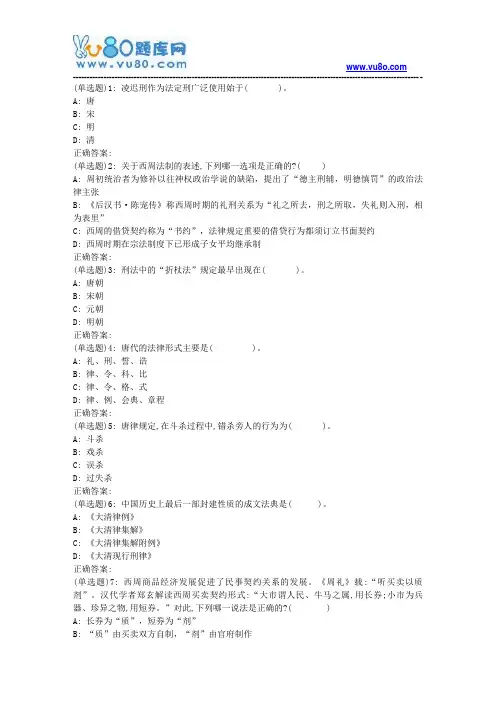
------------------------------------------------------------------------------------------------------------------------------ (单选题)1: 凌迟刑作为法定刑广泛使用始于( )。
A: 唐B: 宋C: 明D: 清正确答案:(单选题)2: 关于西周法制的表述,下列哪一选项是正确的?( )A: 周初统治者为修补以往神权政治学说的缺陷,提出了“德主刑辅,明德慎罚”的政治法律主张B: 《后汉书·陈宠传》称西周时期的礼刑关系为“礼之所去,刑之所取,失礼则入刑,相为表里”C: 西周的借贷契约称为“书约”,法律规定重要的借贷行为都须订立书面契约D: 西周时期在宗法制度下已形成子女平均继承制正确答案:(单选题)3: 刑法中的“折杖法”规定最早出现在( )。
A: 唐朝B: 宋朝C: 元朝D: 明朝正确答案:(单选题)4: 唐代的法律形式主要是( )。
A: 礼、刑、誓、诰B: 律、令、科、比C: 律、令、格、式D: 律、例、会典、章程正确答案:(单选题)5: 唐律规定,在斗杀过程中,错杀旁人的行为为( )。
A: 斗杀B: 戏杀C: 误杀D: 过失杀正确答案:(单选题)6: 中国历史上最后一部封建性质的成文法典是( )。
A: 《大清律例》B: 《大清律集解》C: 《大清律集解附例》D: 《大清现行刑律》正确答案:(单选题)7: 西周商品经济发展促进了民事契约关系的发展。
《周礼》载:“听买卖以质剂”。
汉代学者郑玄解读西周买卖契约形式:“大市谓人民、牛马之属,用长券;小市为兵器、珍异之物,用短券。
”对此,下列哪一说法是正确的?( )A: 长券为“质”,短券为“剂”B: “质”由买卖双方自制,“剂”由官府制作------------------------------------------------------------------------------------------------------------------------------ C: 契约达成后,交“质人”专门管理D: 买卖契约也可采用“傅别”形式正确答案:(单选题)8: 我国第一次公布成文法的人是春秋时郑国的( )。

东大19春学期《软件工程与UML建模》在线作业3
试卷总分:100 得分:100
[试题1]、原型的优点不包括()
A、对设计人员水平及开发环境要求不高
B、可及早为用户提供有用的产品
C、可及早发现问题,随时纠正错误
D、可减少技术、应用的风险
正确选择是:A
[试题2]、判定表和判定树是数据流图中用以描述加工的工具,它常描述的对象是()
A、逻辑判断
B、层次分解
C、操作条目
D、组合条件
正确选择是:D
[试题3]、在实际的开发过程中,纠正了程序中的错误之后,还应该选择部分或全部原先已测试过的用例,对修改后的程序重新测试,这种测试称为()。
A、验收测试
B、强度测试
C、系统测试
D、回归测试
正确选择是:D
[试题4]、软件的集成测试工作最好由()承担,以提高集成测试的效果。
A、该软件的设计人员
B、该软件开发组的负责人
C、该软件的编程人员
D、不属于该软件开发组的软件设计人员
正确选择是:D
[试题5]、下面哪一项不是基本的软件需求()
A、功能需求
B、性能需求
C、环境需求
D、市场需求
正确选择是:D
[试题6]、下面那个量不属于软件度量的范围()。
(单选题)1: ( )是以物质燃烧所产生的火焰热辐射为检测对象的火灾探测方法。
A: 热(温度)检测法 B: 光电探测方法 C: 空气离化火灾探测方法 D: 光辐射或火焰辐射探测方法正确答案:(单选题)2: 增安型防爆仪表指的是( )。
A: 隔爆型 B: 防爆通风充气型 C: 防爆充油型 D: 防爆安全型正确答案:(单选题)3: 以下检测方法中对人体有害,需要做特殊防护的是( )。
A: 超声检测 B: 射线检测 C: 磁粉检测 D: 红外检测正确答案:(单选题)4: 阻燃属于( )技术。
A: 灾前抑制 B: 前兆检测 C: 早期监测 D: 灾害扑救正确答案:(单选题)5: 物位检测仪表,一般要求正常液位为最大刻度的( )左右。
A: 40% B: 50% C: 60% D: 70%正确答案:(多选题)6: 以下能对霍尔电势产生影响的有( )。
A: 霍尔元件的灵敏度B: 激励电流C: 磁感应强度D: 磁场方向和霍尔元件的夹角正确答案:(多选题)7: 以下属于反馈网络的有( )。
一、选择题 (20分。
1.用法扬司法测Cl 时,常加入糊精,其作用是 --------------------------(B )A. 掩蔽干扰离子;B. 防止AgCl凝聚;C. 防止AgCl沉淀转化D. 防止AgCl感光2.间接碘量法中正确使用淀粉指示剂的做法是 ----------------------------( D )A. 滴定开始时加入指示剂;B. 为使指示剂变色灵敏,应适当加热;C. 指示剂须终点时加入;D. 指示剂必须在接近终点时加入。
3.螯合剂二乙三氨五乙酸(EDPA,用H5L表示)的五个p K a值分别为1.94,2.87,4.37,8.69和10.56,溶液中组分HL4-的浓度最大时,溶液的pH值为 ------( D )A. 1.94;B. 2.87;C. 5.00;D. 9.62。
4. K2Cr2O7法测定铁时,哪一项与加入H2SO4-H3PO4的作用无关 ----------( C )A.提供必要的酸度; B.掩蔽Fe3+;C.提高E(Fe3+/Fe2+);D.降低E(Fe3+/Fe2+)。
5.用BaSO4重量分析法测定Ba2+时,若溶液中还存在少量Ca2+、Na+、CO32-、Cl-、H+和OH-等离子,则沉淀BaSO4表面吸附杂质为 ------------------------------( A )A. SO42-和Ca2+; B. Ba2+和CO32-;C. CO32-和Ca2+; D. H+和OH-。
6.以下各条件中何者不是晶形沉淀所要求的沉淀条件 ---------------------(A )A.沉淀作用宜在较浓溶液中进行;B.应在不断的搅拌下加入沉淀剂;C.沉淀作用宜在热溶液中进行;D.应进行沉淀的化。
7.为了获得纯净而易过滤、洗涤的晶形沉淀,要求 ----------------------(A )A.沉淀时的聚集速度小而定向速度大;B.沉淀时的聚集速度大而定向速度小;C.溶液的过饱和程度要大;D.沉淀的溶解度要小。
(单选题)1: 15.最早在企业管理中应用心理学知识的是( )。
A: 雨果·闵斯特伯格B: 莉莲·吉尔布勒斯C: 福兰克·吉尔布勒斯D: 斯特恩正确答案:(单选题)2: 27.( )学说第一次正式将社会学和心理学引入到企业管理的领域中。
A: 科学管理B: 人际关系C: 群体动力D: 需要层次正确答案:(单选题)3: 170.成员的共同性是影响和制约群体凝聚力的重要因素,其中的( )是最关键的因素。
A: 群体的规模B: 群体的领导者C: 群体的地位D: 共同利益与目标正确答案:(单选题)4: 10.泰勒式“科学管理”盛行于( )。
A: 19世纪中叶B: 19世纪末C: 20世纪初 D: 20世纪中叶正确答案:(单选题)5: 8.社会测量法是由( )心理学家莫雷诺在20世纪30年代提出的。
A: 美国B: 法国C: 英国D: 德国正确答案:(单选题)6: 178.一位主管与其他许多人之间的沟通是( )。
A: 链状沟通B: Y型沟通C: 轮状沟通D: 环状沟通正确答案:(单选题)7: 3.通常来说,一个组织包含两个系统,即( )。
A: 技术系统和社会系统B: 社会心理系统和组织管理系统C: 技术系统和社会心理系统D: 技术系统和人际管理系统正确答案:(单选题)8: 98.( )指被宣传者向着宣传者所主张态度相反的方向变化或仍然保持原有的态度。
A: 逆反心理B: 反抗心理C: 对抗情绪D: 反抗情绪正确答案:(单选题)9: 21.被尊称为美国“动作研究之父”的是( )。
(单选题)1: 下列正确的表述是( )。
A: 两链轮应位于同一水平面内,且两轴线平行B: 两链轮应位于同一铅锤面内,且两轴线平行C: 为增大包角,一般链传动的松边布置在上D: 一般链传动的紧边和松边可以布置在上,也可以布置在下,但松边在上为佳正确答案:(单选题)2: 如图所示的极限应力图中,M为工作应力点,应力循环特性r=常数,ON线与横坐标轴的夹角为,则该零件所受应力类型为( )。
A: 不变号的非对称循环变应力B: 变号的非对称循环变应力C: 对称循环变应力D: 脉动循环变应力正确答案:(单选题)3: 下列叙述中正确的是( )。
A: 变应力只能由变载荷产生B: 静载荷不能产生变应力C: 变应力能由变载荷产生,也能由静载荷产生D: 变应力能由静载荷产生正确答案:(单选题)4: 两个等宽的圆柱体接触,其直径d1=2d2,弹性模量E1=2E2,则其接触应力值为( )。
A: B:C:D:正确答案:(单选题)5: 为了限制链传动的动载荷,在链节距河小链轮齿数一定时,应限制( )。
A: 小链轮的转速B: 传递的功率C: 传递的圆周力D: 传动比正确答案:(单选题)6: 循环特性r=-1时的应力是( )。
A: 对称循环变应力B: 脉动循环变应力C: 非对称循环变应力D: 静应力正确答案:(单选题)7: 采用三油楔或多油楔滑动轴承的目的在于( )。
A: 提高承载能力B: 增加润滑油量C: 提高轴承的稳定性D: 减少摩擦发热正确答案:(单选题)8: 有一单个紧螺栓联接,要求被联接件接合面不分离。
(单选题)1: 将一个日期型数据转变为字符串的函数是 。
A: Left( )B: Instr( )C: Str( )D: Cstr( )正确答案:(单选题)2: 下列程序段 能够正确实现:如果X<Y,则A=15,否则A=-15A: If X<Y then A=15A=-15B: A= -15If X<Y then A=15C: If X<Y then A=15else A=-15D: If X<Y then A= -15elseA= 15End if正确答案:(单选题)3: SQL语言删除记录数据的语句是 。
A: InsertB: DeleteC: DropD: Erase正确答案:(单选题)4: 系统的初步调查不包含以下哪个内容? A: 开发会计信息系统的总体目标及近期任务B: 信息系统与系统外界有哪些信息联系C: 新的信息系统开发是否可行D: 计算机应用水平及可供利用的资源正确答案:(单选题)5: SQL语言删除基本表的语句是 。
(单选题)1: 在Sn2+、Fe2+的混合溶液中,欲使Sn2+氧化为Sn4+,而Fe2+不被氧化,应选择的氧化剂是()。
(已知Φ0Sn4+/ Sn2+=0.15V,Φ0Fe3+/ Fe2+=0.77V)A: KIO3(Φ0IO3-/I2=1.20V) B: H2O2(Φ0H2O2/2OH-=0.88V)C: HgCl2(Φ0HgCl2/Hg2Cl2=0.63V) D: SO32-(Φ0SO32-/S=-0.66V)E: S(Φ0S/H2S=0.14V)正确答案:(单选题)2: 指出下列叙述中错误的结论()A: 络合剂的酸效应使络合物的稳定性降低B: 金属离子的水解效应使络合物的稳定性降低C: 辅助络合效应使络合物的稳定性降低D: 各种副反应均使络合物的稳定性降低正确答案:(单选题)3: N离子共存时,可以用控制溶液酸度的方法准确滴定M离子的条件式为()A: lgK′MY-lgK′NY≥5 B: lgcMKMY-lgcNKNY≥5 C: lgcMK′MY-lgcNK′NY≥5 D: lgcMKMY-lgcNK′NY≥5 E: lgcMK′MY-lgcNKNY≥5正确答案:(单选题)4: 用EDTA滴定Mg2+,采用铬黑T为指示剂,少量Fe3+的存在将导致()A: 终点颜色变化不明显以致无法确定终点B: 在化学计量点前指示剂即开始游离出来,使终点提前C: 使EDTA与指示剂作用缓慢,终点延长D: 与指示剂形成沉淀,使其失去作用正确答案:(单选题)5: Ag-AgCl参比电极的电极电位取决于电极内部溶液中()A: Ag+活度 B: Cl-活度C: AgCl活度 D: Ag+和Cl-活度之和正确答案:(单选题)6: 准确滴定金属离子的条件一般为()A: lgcK′MY≥8 B: lgK′MY≥6 C: lgcKMY≥6 D: lgcK′MY≥7 E: lgcK′MY≥6正确答案:(单选题)7: 某指示剂的KHIn=1.0×10-4,则其理论变色范围为()A: pH3~4 B: pH4~6 C: pH3~5 D: pH4~5 E: pH2~6正确答案:(单选题)8: 在滴定分析中,所用试剂含有微量被测组分,应该进行()A: A)、对照试验 B: B)、空白试验 C: C)、仪器校准 D: D)、方法校正 E: E)、增加测定次数正确答案:(单选题)9: 原子吸收分光光度法中,所谓的谱线轮廓是()A: 吸收系数Kν随频率ν的变化 B: 吸收系数Kν随波长λ的变化C: 谱线强度随频率ν的变化 D: 谱线强度随波长λ的变化正确答案:(单选题)10: 下列各项定义中不正确的是()A: A)、绝对误差是测定值与真值之差 B: B)、相对误差是绝对误差在真值中所占的百分比C: C)、偏差是指测定值与平均值之差 D: D)、总体平均值就是真值正确答案:(判断题)11: 色谱的塔板理论提出了衡量色谱柱效能的指标,速率理论则指出了影响柱效的因素。
A: 错误B: 正确正确答案:(判断题)12: 原子光谱理论上应是线光谱,原子吸收峰具有一定的宽度的原因主要是由于光栅的分光能力不够所致。
A: 错误B: 正确正确答案:(判断题)13: 用总离子调节缓冲溶液(TISAB)保持溶液的离子强度相对稳定,故在所有电位测定方法中都必须加入TISAB。
A: 错误B: 正确正确答案:(判断题)14: 浓度为c的H2S溶液的质子条件为:[OH-]=[H+]+[HS-]+[H2S]。
A: 错误B: 正确正确答案:(判断题)15: 玻璃电极的不对称电位可以通过使用前在一定pH溶液中浸泡消除。
A: 错误B: 正确正确答案:(判断题)16: 测定溶液的pH通常采用比较的方法,原因是由于缺乏标准的pH溶液。
A: 错误B: 正确正确答案:(判断题)17: Hg电极是测量汞离子的专用电极。
A: 错误B: 正确正确答案:(判断题)18: 载气流速较低时,增加载气流速,柱效增加,这是由于流速增加,分子扩散影响减小而导致柱效增加。
A: 错误B: 正确正确答案:(判断题)19: 某人分析一矿物中的含硫量,每次取样3.5g,分析结果分别报告为0.04199%、0.04201%是合理的。
A: 错误B: 正确正确答案:(判断题)20: 具有不对称电位是膜电极的共同特性,不同类型膜电极的不对称电位的值不同,但所有同类型膜电极(如不同厂家生产的氟电极),不对称电位的值相同。
A: 错误B: 正确正确答案:(单选题)1: 在Sn2+、Fe2+的混合溶液中,欲使Sn2+氧化为Sn4+,而Fe2+不被氧化,应选择的氧化剂是()。
(已知Φ0Sn4+/ Sn2+=0.15V,Φ0Fe3+/ Fe2+=0.77V)A: KIO3(Φ0IO3-/I2=1.20V) B: H2O2(Φ0H2O2/2OH-=0.88V)C: HgCl2(Φ0HgCl2/Hg2Cl2=0.63V) D: SO32-(Φ0SO32-/S=-0.66V)E: S(Φ0S/H2S=0.14V)正确答案:(单选题)2: 指出下列叙述中错误的结论()A: 络合剂的酸效应使络合物的稳定性降低B: 金属离子的水解效应使络合物的稳定性降低C: 辅助络合效应使络合物的稳定性降低D: 各种副反应均使络合物的稳定性降低正确答案:(单选题)3: N离子共存时,可以用控制溶液酸度的方法准确滴定M离子的条件式为()A: lgK′MY-lgK′NY≥5 B: lgcMKMY-lgcNKNY≥5 C: lgcMK′MY-lgcNK′NY≥5 D: lgcMKMY-lgcNK′NY≥5 E: lgcMK′MY-lgcNKNY≥5正确答案:(单选题)4: 用EDTA滴定Mg2+,采用铬黑T为指示剂,少量Fe3+的存在将导致()A: 终点颜色变化不明显以致无法确定终点B: 在化学计量点前指示剂即开始游离出来,使终点提前C: 使EDTA与指示剂作用缓慢,终点延长D: 与指示剂形成沉淀,使其失去作用正确答案:(单选题)5: Ag-AgCl参比电极的电极电位取决于电极内部溶液中()A: Ag+活度 B: Cl-活度C: AgCl活度 D: Ag+和Cl-活度之和正确答案:(单选题)6: 准确滴定金属离子的条件一般为()A: lgcK′MY≥8 B: lgK′MY≥6 C: lgcKMY≥6 D: lgcK′MY≥7 E: lgcK′MY≥6正确答案:(单选题)7: 某指示剂的KHIn=1.0×10-4,则其理论变色范围为()A: pH3~4 B: pH4~6 C: pH3~5 D: pH4~5 E: pH2~6正确答案:(单选题)8: 在滴定分析中,所用试剂含有微量被测组分,应该进行()A: A)、对照试验 B: B)、空白试验 C: C)、仪器校准 D: D)、方法校正 E: E)、增加测定次数正确答案:(单选题)9: 原子吸收分光光度法中,所谓的谱线轮廓是()A: 吸收系数Kν随频率ν的变化 B: 吸收系数Kν随波长λ的变化C: 谱线强度随频率ν的变化 D: 谱线强度随波长λ的变化正确答案:(单选题)10: 下列各项定义中不正确的是()A: A)、绝对误差是测定值与真值之差 B: B)、相对误差是绝对误差在真值中所占的百分比C: C)、偏差是指测定值与平均值之差 D: D)、总体平均值就是真值正确答案:(判断题)11: 色谱的塔板理论提出了衡量色谱柱效能的指标,速率理论则指出了影响柱效的因素。